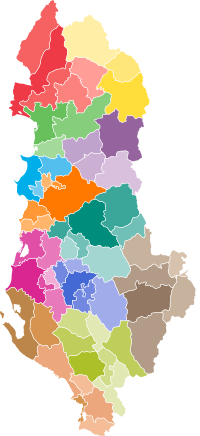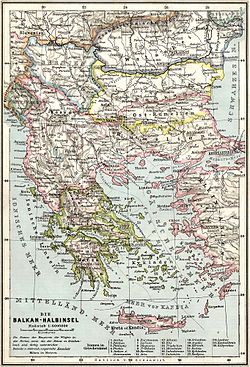Administrative divisions of Albania
| Administrative divisions of Albania Ndarja Administrative e Republikës së Shqipërisë(Albanian) | |
|---|---|
 | |
| Category | Unitary state |
| Location | Albania |
| Number | 12counties 61municipalities 373administrative units 2,972villages |
| Populations | Total:2,845,955 |
| Areas | Total:28,748 km2(11,100 sq mi) |
| Administrative Divisions of Albania |
|---|
 |
Theadministrative divisions ofAlbaniacomprise 12counties,61municipalities,373administrative units,and 2,972villages.Since its1912 Declaration of Independence,Albania has reorganized its domestic administrative divisions 21 times. Its internal boundaries have been enlarged or subdivided intoprefectures,counties,districts,subprefectures,municipalities,communes,neighborhoods or wards,villages,and localities.[1][2][3]The most recent changes were made in 2014 and enacted in 2015.
Main administrative divisions
[edit]Counties
[edit]The first level of government is constituted by the12counties(Albanian:qarqe/qarqet), organized into their present form in the year 2000.[3]They are run by a prefect (prefekt) and a county council (këshill/këshilliiqarkut). Prefects are appointed as representatives of the nationalCouncil of Ministers.[4]
Municipalities
[edit]The second level of government is constituted by the61municipalities(bashki/bashkitë). They are run by a mayor (kryebashkiak/kryebashkiaku) and a municipal council (këshill/këshillibashkiak), elected every 4 years. Before 2015, abashkiwas an urban municipality and only covered the jurisdiction of such cities. After 2015, the jurisdiction of thebashkiwas expanded to cover the nearby rural municipalities.[5][6]
Administrative units
[edit]The third level of government is constituted by the373administrative units(njësia/njësitë administrative) orunits of local administration(njësia/njësitetëqeverisjesvendore). Most of these were formerrural municipalitiesorcommunes(komuna/komunat), which functioned as second-level divisions of the country until 2015. Parts of the administrative units are still further subdivided into Albania's 2,972villages(fshatra/fshatrat).
History
[edit]Ottoman Albania
[edit]
At the beginning of the 20th century, the territory which now forms Albania was divided among the four separatevilayets(Albanian:vilajete/vilajetet) ofScutari,Janina,Manastir,andKosovo.This helped mixAlbanianswith the surroundingGreeks,Serbs,and other groups. The four vilayets were divided into thesanjaks(sanxhaqe/sanxhaqet) ofScutari,Durrës,Ioannina,Ergiri,Preveze,Berat,Manastir,Serfiğe,Dibra,Elbasan,Görice,Üsküp,Priştine,İpek,Prizren,andNovi Pazar.The sanjaks were in turn further divided intokazas(kazaja/kazajat) at the town level andnahiyes(nahije/nahijet) at the village level.
Revolutionary Albania
[edit]Following the successfulWar of Independenceagainst theOttoman Empirein 1912, thefirst Albanian governmentled byIsmail Kemalinitially retained the former Turkish divisions and offices. This was revised by the "Canonof Albanian Civil Administration "on 22 November 1913, which created a new three tier system. The primary division was into the 8 prefectures (prefektura/prefekturat) ofDurrës,Berat,Dibër,Elbasan,Gjirokastër,Korcë,Shkodër,andVlorë.Each of these was to be overseen by a prefect. The prefectures were divided into subprefectures (nënprefektura/nënprefekturat), which were divided into regions or provinces (krahina/krahinat) for local administration.[7]The authority of this provisional government was never recognized by theGreat Powersor theRepublic of Central Albania;never administered territory outside Vlorë, Berat, andLushnjë;and was forced to dissolve after the discovery ofits plot to restore some Turkish controlto gain more territory and better resistSerbia.
Principality of Albania
[edit]
Separately, theInternational Control Commissiondrafted and enacted theOrganic Statute(Statuti Organik)—Albania's firstconstitution—on 10 April 1914.[8]Primarily functioning as a compromise among theGreat Powers of the era,it established thePrincipality of Albaniaas aconstitutional monarchyto be headed by the German princeWilhelm Wiedand his heirs inprimogeniture.[9]
An entire chapter of the Organic Statute was devoted to the administrative division of Albania, explicitly preserving Ottoman names and terms. The primary division was into the 7 sanjaks ofDurrës,Berat,Dibër,Elbasan,Gjirokastër,Korçë,andShkodër.[10]Each would be administered from its namesake city except Dibër.[11]The formerOttoman sanjak of Dibrahad been divided among other countries and the city ofDebarremained outside the principality's borders.[8]The Albanian sanjak of Dibër, however, expanded a bit with the inclusion of districts of the formersanjak of Prizren.[12]Areas ofChameriathat had been in the formersanjak of Ioanninawere added to Gjirokastër and the kaza ofLeskovikwas added to Korçë.[12][13]Each sanjak was overseen by amutasarrif(mytesarif/mytesarifi) appointed by the central government[14]and a sanjak council (këshill/këshilliisanxhakut) consisting of five members appointed by law—a secretary, a comptroller, a director of agriculture and trade, a director of public education, and a director of public works—and one member from each of the sanjak's kazas,[15]elected by the local councils and approved by the mutasarrif.[16]The mutasarrif was personally responsible for maintaining public order,[17]controlling the localgendarmerieandpolicedirectly.[18]He also controlled local budgets in consultation with the council,[19]providing forpublic education[20]and inspecting each of the local kazas at least once a year.[21]
The sanjaks were again divided intokaza,each administered by akaymakam(kajmekam/kajmekami) and his council (këshill/këshilliikazasë),[22]consisting of three members appointed by law—a secretary, a comptroller, and a director of land taxes—and four members appointed by the local councils and approved by the kaymakam.[23]The kaymakam was responsible for the kaza's finances and public services, including issuing passports,[24]and was required to answer to the sanjak's mutasarrif for a number of issues. The kaza was named and administered from the chief town in its district, headquartered at a city hall (bashki/bashkia).[a]Each municipal council was obliged to hold meetings at the city hall at least once a week.[8]
The kaza were again divided intonahiye,which consisted of a group of villages together representing a population of 4000–7000 people.[25]They were administered by amudir(mudir/mudiri) and the local council (këshill/këshillikomunal),[26]consisting of the local secretary and 4 members chosen by public election by themukhtars(muhtarë/muhtarët) of the local villages assembled before the mudir.[27]The mudir was responsible for announcing and enacting the central government's laws, carrying out the census, and collecting taxes;[28]the council was charged with ensuring public hygiene, maintaining local water supplies and roads, and overseeing agricultural development and the use of public lands.[29]
Kingdom of Albania
[edit]
UnderKing Zog,Albania reformed its internal administration under the "Municipal Organic Law" of 1921 and the "Civil Code" of February 1928.
The primary division was into 10prefectures,each led by a prefect. The secondary division was into subprefectures, of which there were 39 in 1927 and 30 by 1934. The subprefects were nominated by the prefects.[30]
The subprefectures were initially divided into 69 provinces, which oversaw local administration through the chiefs of the 2351villages.[7]In 1928, urban centers were reorganized as municipalities governed by a mayor and municipal council popularly elected every three years and rural areas were organized as 160communes.[7]
Occupied Albania
[edit]Following theItalian occupation of Albania,the country was organized into 10 prefectures, 30 subprefectures, 23 municipalities, 136 communes, and 2551 villages.[7]
Communist Albania
[edit]Following the liberation of Albania inWorld War II,Albania maintained its 10 prefectures and 61 subprefectures but abolished its municipalities and communes. A census was conducted in September 1945, and Law No. 284 (dated 22 August 1946) reformed the internal administration of the country once again. It maintained the 10 prefectures, reduced the number of subprefectures to 39, and organized local government as localities (lokalitete/lokalitetet). In 1947, the subprefectures were replaced by 2districts(rrathë/rrathët), with local government divided between towns, villages, and localities.[31]In 1953, Law No. 1707 replaced the prefectures with 10 counties divided into 49 districts and 30 localities. In July 1958, the counties were replaced with 26 districts, including a capital district forTirana.These districts were divided into 203 localities, which oversaw 39 cities and 2655 villages. Larger cities were further divided into neighborhoods or wards (lagje/lagjet). In 1967, the localities were replaced by "unified villages" (fshatra/fshatratibashkuar). By 1968, the 26 districts were divided into 65 cities or urban municipalities (divided into 178 neighborhoods) and 437 unified villages or rural municipalities (divided into 2641 villages). This was largely maintained until the late 1980s. In 1990, the 26 districts were divided into 67 cities (divided into 306 neighborhoods) and 539 unified villages (divided into 2848 villages). The capital Tirana was divided into three regions, each of which was further divided into constituent neighborhoods.[7]
See also
[edit]- Counties,municipalities,communes,andvillages of Albania
- Districts of Albania
- ISO 3166 codes for Albania
- Prefectures of Albania
- Regions of Albania
Notes
[edit]- ^This is the same word as the currentmunicipalities of Albaniabut at the time referred only to the central office of local government, which provided municipal services and saw the meetings of the municipal council.
References
[edit]Citations
[edit]- ^61 bashkitë do të drejtohen dhe shërbejnë sipas “modelit 1958”
- ^"HARTA AD MINIST RATIVE TERRITORIALE E BASHKIVE TË SHQIPËRISË"(PDF).Reformaterritoriale.al.Archived fromthe original(PDF)on 2015-09-24.Retrieved2017-09-09.
- ^ab"HARTA AD MINIST RATIVE TERRITORIALE E QARQEVE TË SHQIPËRISË"(PDF).Reformaterritoriale.al.Archived fromthe original(PDF)on 2018-09-05.Retrieved2017-09-09.
- ^"LIGJ Nr. 8927, date 25.7.2002: Per Prefektin (Ndryshuar me Ligjin Nr. 49/2012" Për Organizimin dhe Funksionimin e Gjykatave: Administrative dhe Gjykimin r Mosmarrëveshjeve Administrative ""(PDF).Planifikimi.gov.al.Archived fromthe original(PDF)on 2016-03-05.Retrieved2017-09-09.
- ^"HARTA ADMINISTRATIVE TERRITORIALE E BASHKIVE TË SHQIPËRISË"(PDF).Ceshtjetvendore.gov.al.Archived fromthe original(PDF)on 2016-03-06.Retrieved2017-09-09.
- ^"STAR 2 – Consolidation of the Territorial and Administrative Reform".
- ^abcde"Reforma Territoriale – Historik".Reformaterritoriale.al.Retrieved9 September2017.
- ^abcStatuti Organik i Shqipërisë(PDF)(in Albanian).
- ^"Lo statuto dell'Albania – Prassi Italiana di Diritto Internazionale".www.prassi.cnr.it.Retrieved2021-12-10.
- ^Statuti Organik,Ch. VI, §95.
- ^Statuti Organik,Ch. VI, §96.
- ^abStatuti Organik,Ch. VI, §98.
- ^Clayer 2005,pp. 319, 324, 331.
- ^Statuti Organik,Ch. VI, §100.
- ^Statuti Organik,Ch. VI, §110.
- ^Statuti Organik,Ch. VI, §111.
- ^Statuti Organik,Ch. VI, §106.
- ^Statuti Organik,Ch. VI, §101.
- ^Statuti Organik,Ch. VI, §103.
- ^Statuti Organik,Ch. VI, §108.
- ^Statuti Organik,Ch. VI, §104.
- ^Statuti Organik,Ch. VI, §119.
- ^Statuti Organik,Ch. VI, §125.
- ^Statuti Organik,Ch. VI, §123.
- ^Statuti Organik,Ch. VI, §132.
- ^Statuti Organik,Ch. VI, §133.
- ^Statuti Organik,Ch. VI, §134.
- ^Statuti Organik,Ch. VI, §135.
- ^Statuti Organik,Ch. VI, §136.
- ^""Historia e ndarjes administrative nga Ismail Qemali në '92"".Panorama.com.al.Retrieved9 September2017.
- ^"Historia e ndarjes administrative nga Ismail Qemali në '92".Shtetiweb.org.23 April 2014.Retrieved9 September2017.
Bibliography
[edit]- Clayer, Nathalie (2005)."The Albanian students of the Mekteb-i Mülkiye: Social networks and trends of thought".In Özdalga, Elisabeth (ed.).Late Ottoman Society: The Intellectual Legacy.Routledge.ISBN9780415341646.

